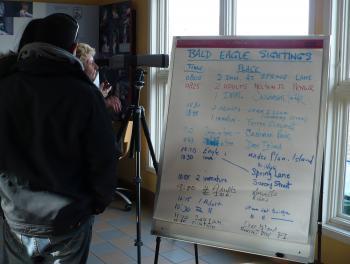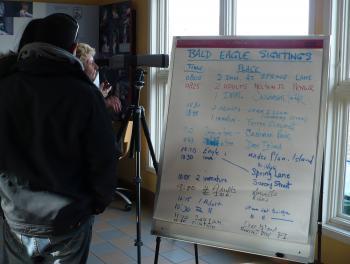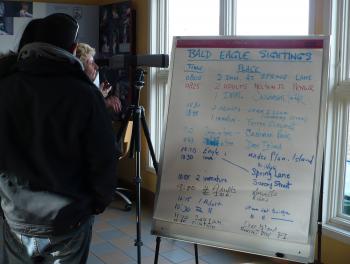NEWBURYPORT, Mass.—On Saturday, Feb. 13, it was all about eagles in this historic seaport situated at the mouth of the Merrimack River, where it empties into the Atlantic.
The fifth annual Merrimack River Eagle Festival, presented by the Massachusetts Audubon Society’s Joppa Flats Education Center and the Parker River National Wildlife Refuge, attracted crowds of people of all ages, and all with one thing in common—the desire to see a bald eagle in the wild.
They came equipped with binoculars and cameras of all sizes and types. Many toted tripods, and were well-dressed for staying outside in the cold for long stretches of time in hopes of getting a look at the impressive birds.
Eagle- and raptor-related educational events were held in several locations, including City Hall. Tour buses, booked in advance, left from the Chamber of Commerce to take bird-watchers to “hot spots” for eagle sightings.
As part of the fun activities, children could learn about building an eagle’s nest. The nests are made of sticks, lined with grass and moss, and can be as much as 13 feet deep, 8 feet across, and several feet thick, weighing hundreds of pounds, as a nesting pair keeps adding new material every year.
Eagles mate for life and can live up to 30 or 40 years. They have a wingspan of about 6 to 8 feet and can weigh between 7 and 15 pounds, with the female being larger than the male. They are birds of prey or raptors, like hawks, vultures, owls, and osprey, among others. They eat mostly fish but also are known to kill waterfowl and small animals as well as scavenge and steal food from other birds.
It was a perfect day for bird-watching, sunny and clear with little wind, and the birds were cooperating. Sightings of bald eagles, both mature ones with their classic white plumage and immature birds with dark feathers, were noted at designated viewing spots along the river from the Interstate 95 area to Plum Island.
Mid-winter is the best time to see eagles, especially in the lower part of the Merrimack River around Amesbury, Salisbury, and Newburyport, since the water does not freeze in this area. The birds migrate from the north, primarily from Canada, as the waterways freeze over and their food sources disappear. They migrate south along the coast and major rivers in search of open water to fish. Colder weather to the north drives more birds south in search of food.
“This is like Florida for them,” says Steve Olson, president of the Eastern Massachusetts Hawk Watch, who was at the Joppa Education Center on Saturday with his wife, Kathy. He also said that it is not known how many of the eagles are migrants and how many are residents. The migratory eagles will return north to rebuild their nests and lay eggs.
The fifth annual Merrimack River Eagle Festival, presented by the Massachusetts Audubon Society’s Joppa Flats Education Center and the Parker River National Wildlife Refuge, attracted crowds of people of all ages, and all with one thing in common—the desire to see a bald eagle in the wild.
They came equipped with binoculars and cameras of all sizes and types. Many toted tripods, and were well-dressed for staying outside in the cold for long stretches of time in hopes of getting a look at the impressive birds.
Eagle- and raptor-related educational events were held in several locations, including City Hall. Tour buses, booked in advance, left from the Chamber of Commerce to take bird-watchers to “hot spots” for eagle sightings.
As part of the fun activities, children could learn about building an eagle’s nest. The nests are made of sticks, lined with grass and moss, and can be as much as 13 feet deep, 8 feet across, and several feet thick, weighing hundreds of pounds, as a nesting pair keeps adding new material every year.
Eagles mate for life and can live up to 30 or 40 years. They have a wingspan of about 6 to 8 feet and can weigh between 7 and 15 pounds, with the female being larger than the male. They are birds of prey or raptors, like hawks, vultures, owls, and osprey, among others. They eat mostly fish but also are known to kill waterfowl and small animals as well as scavenge and steal food from other birds.
It was a perfect day for bird-watching, sunny and clear with little wind, and the birds were cooperating. Sightings of bald eagles, both mature ones with their classic white plumage and immature birds with dark feathers, were noted at designated viewing spots along the river from the Interstate 95 area to Plum Island.
Mid-winter is the best time to see eagles, especially in the lower part of the Merrimack River around Amesbury, Salisbury, and Newburyport, since the water does not freeze in this area. The birds migrate from the north, primarily from Canada, as the waterways freeze over and their food sources disappear. They migrate south along the coast and major rivers in search of open water to fish. Colder weather to the north drives more birds south in search of food.
“This is like Florida for them,” says Steve Olson, president of the Eastern Massachusetts Hawk Watch, who was at the Joppa Education Center on Saturday with his wife, Kathy. He also said that it is not known how many of the eagles are migrants and how many are residents. The migratory eagles will return north to rebuild their nests and lay eggs.




